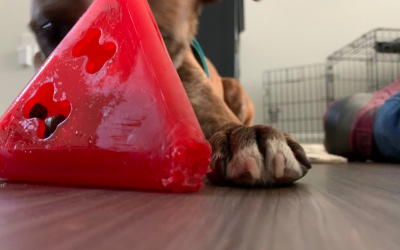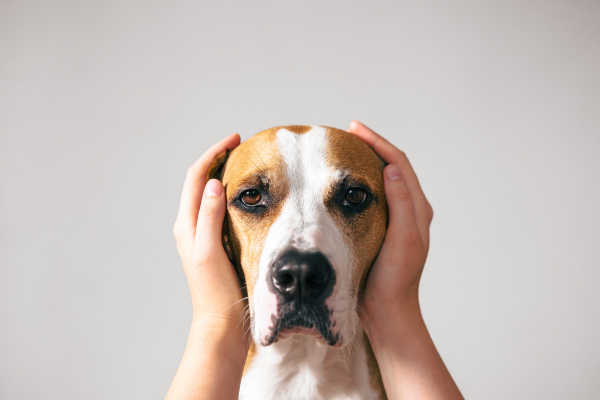10 Ways to Help Your Fearful Dog: Expert Guidance for Anxious Pets
I have a fearful dog. OK, I have two fearful dogs. And two shy cats. (I told you I had a special place in my heart and, apparently, my home for worried pets.)
Your world can be a little bit smaller when you live with a fearful dog. It’s easy to get discouraged, but know that many people are experiencing the same things with their dogs as you are. You’re not alone.
Understanding Fearful Dog Behavior
Fear in dogs generally falls into three categories: fear of environmental stimuli, fear of other dogs, and fear of new humans. This post focuses on dogs who are afraid of new humans. Remember, we should always assume a fearful dog will bite and do our very best to prevent it.
What Causes Fear in Dogs?
Socialization, exposure, genetics, epigenetics, maternal nutrition, and traumatic experiences all contribute to a dog’s fearfulness. Every dog is an individual, and what causes fear in one dog may not affect another.
10 Ways to Help Your Fearful Dog
1. Learn your dog’s early warning signs.
Many people miss the early signs of anxiety and fear until they become apparent. To get started, you can take our course on Dog Body Language. Recognize early signs of stress like lip licking, yawning, turning away, stiff posture, or wide eyes. Help your dog out by giving them space.
2. Keep your dog feeling safe.
Protect your dog by avoiding situations that might trigger fear responses. Don’t expect your dog to “get used to” strangers by being exposed to them repeatedly. That’s called flooding, and it often makes the fear worse. Avoid crowded places and skip having guests over if possible. If visitors are unavoidable, it’s best to put your dog in a quiet, secure space. If you don’t have a yard and need to do potty walks, keep them brief and aim for quiet times of day. Or consider transporting your dog to less busy areas. Walks are often overemphasized; it’s okay to skip them if your dog is not enjoying them. For dogs too afraid to go outside, you might even explore an indoor potty solution while you work through training. Giving your dog a break from stressful encounters is not giving up—it’s smart, compassionate training.
3. Reduce your dog’s stress.
Managing your dog’s stress is essential for real, lasting behavior change. Dogs learn best when they’re not overwhelmed. You can lower stress in many ways. Keep your dog’s routine predictable, as consistency helps reduce anxiety. Add daily enrichment like puzzle toys, sniff walks, and food-based activities. These calming outlets help lower your dog’s overall stress level, making it easier for them to cope with things that feel scary.
4. Avoid punishment.
I know how hard it is when your dog reacts in public, but tools like prong collars, shock collars, leash corrections, or yelling will always make things worse, especially for sensitive dogs. These methods punish your dog for expressing fear, which doesn’t change the emotion. It only suppresses the behavior, and suppressed fear can eventually explode. Humane, science-based methods are safer and more effective for long-term success.
5. Consult your veterinarian.
A thorough wellness check is always recommended because pain and discomfort contribute to behavior. Some dogs may benefit from behavior medication to aid behavior modification. It’s hard to learn new skills when your brain is being hijacked by stress.
6. Change how your dog feels by understanding how they learn.
Obedience training won’t change how your dog feels about their triggers. To change how your dog feels, you’ll need to understand how they learn. This means gradual, intentional desensitization and counterconditioning. And no, your dog’s breed doesn’t require special training.
7. Work with an experienced, positive trainer.
Early intervention is most effective with the support of a qualified trainer. But not all trainers are created equal. Dog training is an unregulated industry, so choosing someone with real credentials matters. While professional help may feel like a significant investment, working with an underqualified trainer will likely cost you more in the long run, in terms of time, money, frustration, and emotional stress.
8. Give your dog choices.
Never force your dog into situations they’re not ready for. They should always have the option to move away. That means we don’t ask for obedience (like sit or stay) in the face of fear. You’re dog can’t make good choices or even hear your words when they are freaking out. Your dog isn’t giving you a hard time; they are having a hard time. Respecting their need to opt out is critical to building trust.
9. Set realistic goals.
Your dog will never be a social butterfly, but they can live a happy, full life. Your behavior professional will help you understand what you can expect your dog to achieve and help you set about a plan to get there. You may be surprised!
10. Remember that slow progress is still progress.
Avoid overwhelming your dog and celebrate small victories. A common DIY mistake is moving too fast and skipping steps, which sets your dog up to fail. Think of training like swimming: You don’t jump in the deep end until you at least know how to doggy paddle. Progress takes patience and planning. Go slow—slower than you think, as slow as your dog needs.
Loving and being loved by a fearful dog is an honor. The work you put into keeping your dog feeling safe and comfortable will be gratifying when you start seeing your dog find joy where it wasn’t before.
See the following blogs for more information:






